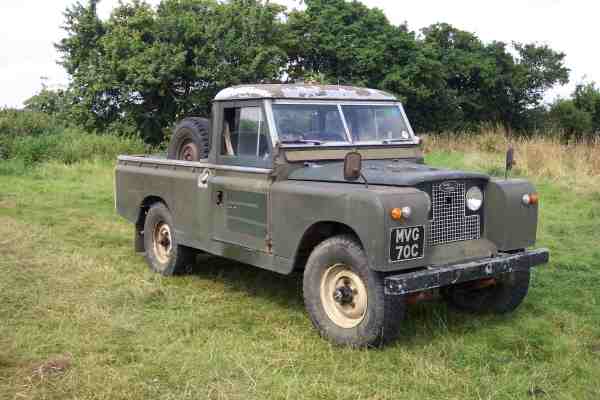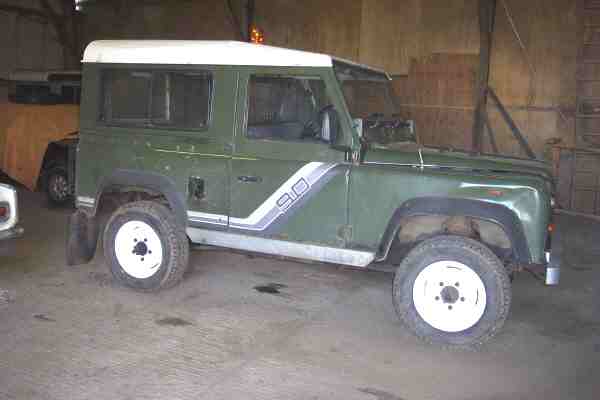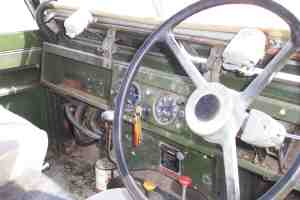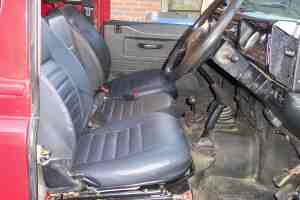![]()

Living with an older Land Rover
The ups and
downs of classic Landie ownership
![]()
![]()
I get a lot of enquiries from people who have never before owned a Land Rover, and who fancy one of the older vehicles as an introduction to Land Rover ownership. Perhaps they have a limited budget, only need the vehicle for occasional use, don't want to tie up a huge sum of money in a vehicle that only gets used to take the dogs to the beach, like the idea of saving £190 a year in road tax, or maybe they just like the look of the older vehicles.
An older Land Rover, whether an early coil-sprung 90 or 110, or one of the classic leaf sprung 'Series' models, can be a faithful and durable friend, but you really need to go into the purchase with your eyes wide open and use some common sense. Only a couple of weeks ago I was offered a vehicle very cheaply by someone who had fancied 'an old Land Rover' and had gone out and bought the first one he looked at. It was, in every way, a bad purchase. It was a long-wheelbase model, so he could barely get it into his tightly curved driveway. It was a 2.25 3-bearing diesel, and he had bought it with a view to towing his boat down to the South Coast once a month, a 400 mile round trip for which a slow, noisy, underpowered vehicle was desperately ill-suited. The chassis was a patchwork quilt of plates welded on top of other plates, and the bulkhead wasn't much better. It had been through ten owners, none of whom had ever spent any money on it, and mechanically it was about as bad as they get. Every week it broke down, he took it into the garage and was presented with a large bill. Now he just wanted to get rid of the thing, and swore never to buy another Land Rover again.
What is really sad is that, for the money he ploughed into this rolling wreck, if he had done some basic research, taken good advice and really thought about his requirements, he could have had a nice, well-maintained older vehicle which would have lasted him many, many years. (I didn't buy his vehicle by the way, but someone on eBay did...)
So what do you need to think about, and beware of, when considering spending £2,000 - £3,000 (the most common price range I am asked to supply vehicles in) on an older Land Rover?
General points first. This kind of money will not stretch to a post 1990 Defender TDi, at least not one that any sensible buyer would touch with a bargepole. So the vehicles you are looking at will be OLD. At least fifteen years old, possibly forty or even older. Land Rovers are mechanically complex and incorporate some very old fashioned technology. This means that however clean, well-maintained and low mileage your vehicle, it WILL break down at some point, and it WILL require money spending on it, on a regular basis, to keep it in good mechanical condition. If that is unacceptable to you, go and buy a new Nissan X-Trail.
A Land Rover is designed as a fairly uncompromising off-road workhorse for farmers, the military and construction workers. By passenger car, or even modern 4X4 standards, it will be slow, noisy, ill-handling, with an uncomfortable driving position, minimal creature comforts and heavy controls. This applies much more to the older vehicles, but even a Ninety can be a bit of a culture shock if you are used to driving a 3-series BMW to work every day. This rugged, uncompromising, utilitarian nature is part of the Land Rover's enduring appeal, but it is not to all tastes. Make sure you understand what an older Land Rover is all about before you buy one. It isn't a cool-looking alternative to a Suzuki Jeep or Toyota RAV-4. It's more like a tractor that you can use to take the kids to school in.
Safety equipment - you get seatbelts, and a big heavy ladder frame chassis that will give you plenty of protection in front or rear impacts, but absolutely none in side collisions or rollovers. That's all. No airbags, anti-lock brakes, electronic stability aids, traction control or any of the other stuff that keeps drivers of modern cars out of trouble. If you drive an older Land Rover like a modern car, two things will happen: you will crash, and it will hurt a lot.
Now let's look at some of the issues specific to particular models.

Series IIA in original unrestored condition. A fifty year old vehicle still doing the job it was built to do. Lovely.
Series II (1958-61), Series IIA (1961-71): Everyone's idea of what a proper classic Land Rover should look like. Headlamps mounted close together in the centre of the grille panel until 1968, when they were moved out to the wings. These vehicles were strongly built of good quality materials (they predated the British Leyland era) and there are a surprising number still around, and not too expensive either. Only very minor detail differences between the Series II and IIA, which means that the design of these vehicles is now getting on for half a century old. What does that mean?
Firstly, they are not really up to modern traffic conditions without some important improvements. The main ones are:
-
Brakes - these vehicles did not have power assisted brakes, so the brakes are very, very heavy indeed. Also they had single circuit brakes - so if a leak develops anywhere in the system, you only have the handbrake to stop you.
-
Performance - the 2.25 petrol is just about powerful enough to keep up with modern traffic, but the diesel engine is underpowered, noisy and tends to self-destruct if worked too hard. Realistically, top speed is 55 mph in a petrol vehicle, 45 in a diesel. Try driving everywhere at 45 in your car, and see how long a queue builds up behind you. Try doing it on the motorway, and see how quickly you get rear-ended by an East European artic. An overdrive will raise the cruising speed by 10 mph, but the diesel in particular will always struggle on hills, more so when heavily laden or towing.
-
Ride and handling - these vehicles use very old leaf-spring technology, and although the ride on new springs and shocks is tolerable, it deteriorates very badly as these components age. The steering is non-assisted, low geared and heavy. The turning circle is fairly large on short wheelbase vehicles, supertanker-huge on long wheelbase ones.
-
Controls - the clutch can be very heavy (a real pain, literally, in traffic jams), the switchgear is scattered all over the dashboard, poorly marked and hard to read, brakes and steering as mentioned above are heavy and imprecise in feel, and the gearchange takes care and practice to master. There is no synchromesh on first or second gear (a hangover from the Land Rover transmission's pre-war roots) so you will need to rediscover the lost art of double-declutching when changing up or down. All this gives every journey a feeling of adventure, but if you just want an unchallenging, straightforward drive, one of these vehicles is not for you.
-
Comfort - you get flat slabs of black vinyl-covered foam to sit on, non-retracting seatbelts and sliding side windows which let in draughts. Rainwater leaks round the corners of the windscreen and drips onto your legs. The heater is feeble. The seats have very limited adjustment and no headrests. The driving position is strange - like sitting at a school desk, back upright with your feet flat on the floor. There is no stereo, and no point in fitting one because you won't be able to hear it with the engine running.
-
Electrics - the vehicles have dynamo charging systems, long since obsolete. These do not provide enough power to keep the battery charged when using all the electrics. Headlamps, wipers and heater - you can have any two out of three, but not all three, unless you want to end up with a flat battery. The problem is worst at low speeds - so if you want to use the vehicle for winter commuting in heavy traffic, you need to do something about it. And the lights are inherently unreliable. Just remember the motto of the classic British vehicle owner: "Lucas Electrics - Home Before Dark!"
-
Fuel - petrol engines will not run on unleaded without either cylinder head modifications (approx £350-£400) or a fuel additive. The same applies if you are planning to convert the vehicle to run on LPG.
There are solutions available to all these problems, but (of course) they cost money. So you have to decide which of these defects you can live with, and which you must fix. This will depend on the use to which you plan to put the vehicle. Bottom line is, is you are doing more than about 3,000 miles a year, using the vehicle as daily transport, covering a lot of motorway miles or will struggle with heavy hand or foot controls, one of these vehicles is not for you, unless you can afford to have it updated to a more modern specification.
The next point to consider is that these vehicles, even when in good order, are quite heavy on maintenance (just like any other 40 year old car) and need regular checking, lubricants topping up etc to spot emerging problems before they become serious enough to immobilise the vehicle. If you have no mechanical skills or sympathy, you will develop a very close and financially crippling relationship with your local garage. I'm not saying that you need to be able to strip and rebuild a gearbox by the roadside with a Swiss Army knife and some baler twine - but some basic mechanical understanding will greatly help to keep the relationship with your vehicle a happy one.
But don't forget the good points. These vehicles are simple, sturdy and easy to work on. Most parts are still available, and very cheaply at that. You can insure them on a classic car policy, there's no road tax to pay, and of course you have a genuine icon of British design, instantly recognisable the world over. These are the vehicles that made Land Rover's reputation, and you will feel very proud to own a vehicle which is maybe 40+ years old, still doing the job for which it was designed. They are real fun to drive, a properly involving driving experience, and they look great. Just don't expect them to be modern, because they aren't.

This Series III from 1981 has had a much harder life than the IIA pictured above. I sold this one for rebuilding.
Series III, 1971-84: If these vehicles look similar to the Series IIA, that's because they are. They got a new dashboard with instruments and switchgear in front of the driver, synchromesh on all gears, alternator charging and slightly better interior trim, but in essence they are still the same 1958-vintage design, with most of the same usability and comfort issues. As production went on through the strike-bound Seventies, quality became very erratic, with chassis corrosion in particular becoming a major issue towards the end of the production run. But the design was steadily refined and improved through its life, and the following items are well worth looking out for:
-
5-bearing engines - both petrol and diesel from 1980. Smoother and far more durable at motorway speeds. Can be retrofitted to earlier vehicles - but the older 3-bearing engine can be fitted to late vehicles as well, so you need to check the engine serial number.
-
Power brakes - available on many though not all Series III vehicles. All but the early ones had dual circuit brakes, and post 1980 short wheelbase vehicles like the one pictured above had the same front brakes as long wheelbase models - much more powerful.
-
Deluxe and County trim - interior trim panels, more comfortable shaped seats to cut down noise and improve driver comfort. Later vehicles had retracting seat belts as well.
Stage One V8 (1979-83) was a totally different animal, with 3.5 litre V8 power and permanent four wheel drive. Perhaps the most usable Series III, especially if converted to run on LPG, but only available here in long wheelbase form.
The Series III is perhaps not quite as pure a piece of design as the Series II/IIA, and only the very earliest (1972) vehicles are tax exempt. But there are huge numbers about, and a late one in good condition will still be up to pretty much any job you ask of it.

Typical example of a hard-working Ninety - actually my old workhorse, now gone to a new home.
Ninety and One Ten, 1983-90*: A quantum leap forward in comfort and usability, despite being initially little more than a Series III body on an old Range Rover chassis. Ninety is short wheelbase, One Ten is long wheelbase. Coil spring suspension gives vastly improved ride and handling, power assisted brakes (discs at front) on all models from the start, as was permanent four wheel drive (which greatly aids stability). Interiors better trimmed, wind-up windows on all but the very first One Tens, power steering (optional, but a common fitment), a new 5-speed gearbox for relaxed motorway cruising, better seats, better mirrors - the list goes on. The turning circle, though still large, is far more manageable than a Series III. They still need a lot of servicing, but at longer intervals than the older vehicles. Engines are more powerful (except the very early ones). So why wouldn't you buy one instead of a Series vehicle?
*Sometimes you see pre-1990 vehicles described as Defenders. This is incorrect - the Defender model name did not appear until the new TDi engine was introduced in 1990.
Reasons Not To Buy A Ninety Or One Ten:
-
Their popularity. Precisely because they are so much more usable in modern conditions than the Series vehicles, demand even for older vehicles remains high. That means that the same money that will buy a clean, well-loved Series II or III will only stretch to a fairly shabby, hard-worked Ninety. You don't get something for nothing.
-
Their complexity. The coil spring suspension has lots of bushes which wear and can be expensive and time-consuming to replace. The permanent four wheel drive system is more complex than the selectable system on the Series vehicles and expensive to fix if it goes wrong. Electrical systems are more complex, and faults therefore harder to trace. Wind-up windows and push-button door handles provide an unending source of irritating problems which just don't exist on a Series vehicle.
-
Their (lack of) quality. Early One Tens (sliding side windows) seem to have been better built and painted than the last of the Series IIIs, but it all went downhill from there. There are major issues, particularly on late Eighties vehicles, with chassis rot and especially with bulkheads rotting away just below the windscreen and around the top door hinge. Doors corrode internally and fall apart, and cost about four times as much to replace as the two-piece Series doors. Wiper motors lose their self-parking function. Power steering has unreliability built in as standard. Turbodiesels (pre TDi) blow up. Gearboxes break expensively, losing all drive to the wheels, due to a design fault which Land Rover took 14 years to fix.
-
Their ubiquity. These vehicles are absolutely everywhere. If you want something distinctive which stands out from the crowd, a Ninety or One Ten is not the way to go. You can paint it bright yellow, stick aluminium chequerplate all over the outside, fit a bullbar, huge wheels, half a dozen spotlights and jack up the suspension, and the next day you'll meet another one coming the other way, to which its owner has done exactly the same as you have to yours.
But if you plan to do a lot of miles, want a Land Rover to use as your only vehicle, need power steering, suffer from back problems or spend all your life on the motorway, a Ninety or One Ten is probably your best choice. However, you need to be very careful buying one of these vehicles. With a Series II or III, if the chassis and bulkhead are sound (and they are pretty easy to inspect) then most other problems can be sorted out fairly cheaply. But turning a tired Ninety into reliable transport can become a very expensive game indeed. There are far more bad examples out there than good ones, and shiny paintwork is no guide to what lies underneath.


Compare and contrast - Series IIA on left, Ninety on right